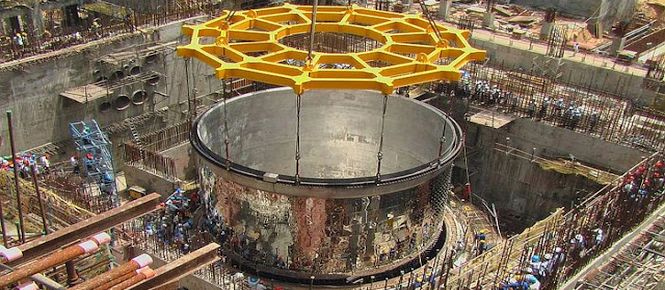As India’s first prototype fast breeder reactor (PFBR) slowly moves closer towards commissioning, plans are afoot to make six more similar nuclear power reactors operational by 2039.
Construction of two of these six fast reactors is scheduled to begin in 2021 in Kalpakkam in Tamil Nadu. They are expected to start commercial operation by 2029 and 2031, respectively, adding 1,200 MW of electricity to the southern grid.
The other four would be built at a new site from 2025 onward and would start generating electricity between 2031 and 2039, said sources in the Department of Atomic Energy.
However, the scheduling of future fast reactors depends, to a large extent, on the performance of the 500 MW prototype reactor, which is eight years behind schedule.
The PFBR missed yet another target date of completion in October 2017 and now is expected to be commissioned by mid-2018.
“The 500 MW prototype fast breeder reactor is under advanced stage of commissioning. Sodium coolant has been poured into the secondary system of the reactor. It would take another six months before fuel loading,” V Rajan Babu, director (technical) at Bharatiya Nabhikiya Vidyut Nigam Ltd, the public sector undertaking that is building the fast reactors, told DH.
Once functional, the fast breeder reactor would usher in the second stage of India’s three-stage nuclear power programme as envisioned by Homi J Bhabha, the father of Indian nuclear programme.
Fast breeder reactors “breed” more fissile material than the fuel they consume. They burn plutonium – generated in Uranium-fueled pressurised heavy water reactors and light water reactors – to breed a special type of fissile uranium known as U-233, which is used as fuel. Currently, there is only one fast breeder reactor in the world, BN-800 in Russia.
Earlier, the Department of Atomic Energy had planned that the six future breeder reactors would be of 500 Mwe capacity. “The plan was modified later to make them 600 Mwe each for higher safety level and better economy,” Babu said.
Design of fast reactors, in particular after the Fukushima accident, has led to adopt additional safety features besides having more conservative design parameters for external events, emphasis on in-service inspection and minimising the consequences of whole core accident, said S C Chetal, former director of Indira Gandhi Centre for Atomic Research, Kalpakkam that designed the PFBR
source- deccan herald

November 10, 2017 at 3:48 pm
The commissioning of nuclear reactors may increase India’s nuclear power capability but there are hazards associated. Hence, the safety of people should also be addressed